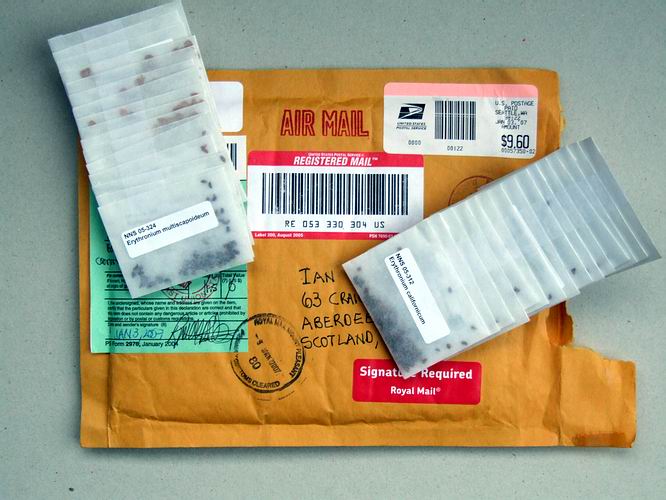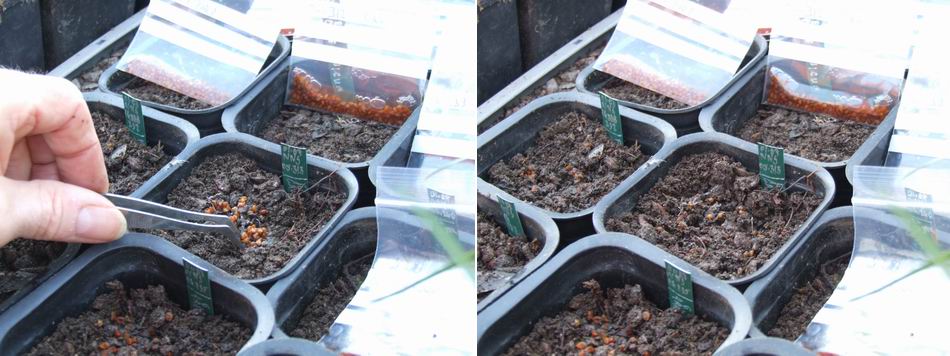|
BULB LOG 03 --- 17th January 2007

Medal and Certificate
I have been told that I have to tell you that The Royal Caledonian Horticultural Society has just made an award to Maggi and I of 'The Queen Elizabeth, The Queen Mother Medal in Horticulture' in appreciation of outstanding services in Scottish Horticulture, their words not mine. We are of course delighted to be recognised in this way by our peers from the wider horticultural world. As so much of what we do is through and with the SRGC we feel that we accepted the Medal on behalf of all our fellow Club Members as well.

Packet of seeds arrives
The other excitement of this past week was the arrival of our packet of seeds from Ron Ratko of North West Native Seeds. Ron is one of my favourite sources for the North American Fritillarias and Erythroniums, with known and detailed locations plus field notes, thank you Ron.

Engrave labels
The first task is always to engrave the labels made from cutting down old aluminium venetian blinds. As my smallest engraving tool has finally packed up after 20 years or more I am now using my slightly bigger multipurpose Dremel; every home should have one. It is a bit more of a handful but once you get used to it you can engrave the labels almost as quickly as you could write them.

Fritillaria seed in packets
I know that I normally say that I do not sow Fritillaria seeds after the turn of the year, preferring to store them until August/September before I sow them, however for every rule there is an exception. I have had lots of reports from other growers that they have had successful and speedy germination by sowing the North American Fritillarias now so just to prove that you can teach an old dog new tricks I am trying it out. I will keep you well posted on their progress.

Sowing Fritillaria seed
I fill the seed pots to within 1 or 2 cms of the top, match the seed packets to the labels that I have placed in each pot, then scatter the seeds across the surface of the compost.

Sowing Fritillaria seed stage 2
There is no need to be too accurate in your spacing of the seeds so long as they are reasonably well distributed across the surface and not all piled into one corner. I then take a small pair of bent forceps and lightly rake the surface. This helps even out the seeds and also turns some onto their edges letting them just penetrate the compost. There is less chance of the papery seeds rotting off if they are sown on their edge, ideally pointed end down into the compost with the top just showing for best results. If you have lots of time and only a few seeds then you are better to place each one individually in that position but I have too many seeds and never enough time.

Top off with gravel
Next I top off with 1 to 2cms of 6mm gravel and then I hold each pot by a corner and give it a gentle shake to level off and bed in the gravel. These pots are now placed outside to take the weather and get a good soaking from the rain for a few weeks and then I will move them under glass.

Transfer erythronium seeds to plastic packets
The biggest part of my order was for erythronium seeds, no surprises there then!
I treat these slightly differently. First I transfer them all into small plastic packets, taking care to identify each one, and into each packet I add a small amount of water with the smallest amount of soap to break the surface tension - these are then left to soak over night.

Seeds before and after soaking
Above I show the same two packets; the two at the top are the dry seeds and the same two packets, below, after an overnight soak. Even in this picture I am sure that you can see how the seeds have absorbed moisture and plumped up nicely; this should result in an earlier and more even germination.

Sowing Erythronium seed
I also sow the Western North American seeds on the surface pulling the wet seeds out of the packets with my trusty bent forceps into a clump on the soil surface.

Raking seeds in
Then I spread the seeds across the surface of the compost again with the same pair of forceps.

Top off with 6mm gravel
These pots are also topped off with gravel and placed outside to take the weather. Unlike the Fritillaria seed pots, I will not bring them under glass as I prefer to grow my erythroniums completely in the open frames, only giving the a cover if we get late frost and snow after they start to germinate. Again I will keep you posted with their progress as we go through the year.

Exhibition closes
I started on a personal note so I will finish on one as well: my art exhibition which I told you about at the opening on the 30th of November came down on Monday. As so many of you wished me well and have been enquiring how it went I am delighted to report that there were 40 works on the walls, 39 sold and one was not for sale, I call that a good result.
^ back to the top ^
|

